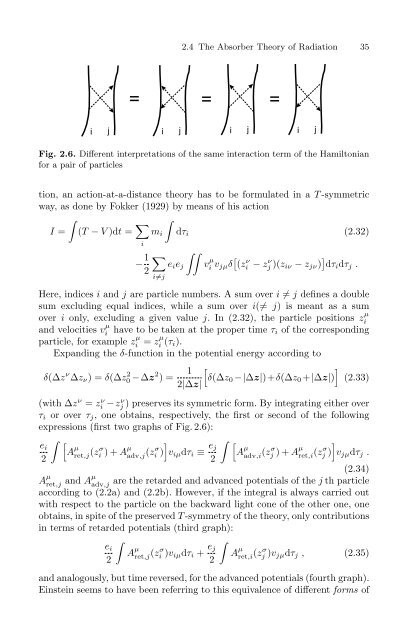The Physical Basis of The Direction of Time (The Frontiers ...
The Physical Basis of The Direction of Time (The Frontiers ...
The Physical Basis of The Direction of Time (The Frontiers ...
You also want an ePaper? Increase the reach of your titles
YUMPU automatically turns print PDFs into web optimized ePapers that Google loves.
2.4 <strong>The</strong> Absorber <strong>The</strong>ory <strong>of</strong> Radiation 35<br />
= = =<br />
i j i j i j i j<br />
Fig. 2.6. Different interpretations <strong>of</strong> the same interaction term <strong>of</strong> the Hamiltonian<br />
for a pair <strong>of</strong> particles<br />
tion, an action-at-a-distance theory has to be formulated in a T -symmetric<br />
way, as done by Fokker (1929) by means <strong>of</strong> his action<br />
∫<br />
I = (T − V )dt = ∑ ∫<br />
m i dτ i (2.32)<br />
i<br />
− 1 ∑<br />
∫∫<br />
e i e j<br />
2<br />
i≠j<br />
v µ i v jµδ [ (z ν i − z ν j )(z iν − z jν ) ] dτ i dτ j .<br />
Here, indices i and j are particle numbers. A sum over i ≠ j defines a double<br />
sum excluding equal indices, while a sum over i(≠ j) ismeantasasum<br />
over i only, excluding a given value j. In (2.32), the particle positions z µ i<br />
and velocities v µ i have to be taken at the proper time τ i <strong>of</strong> the corresponding<br />
particle, for example z µ i = z µ i (τ i).<br />
Expanding the δ-function in the potential energy according to<br />
δ(∆z ν ∆z ν )=δ(∆z0 2 −∆z 2 )= 1 [<br />
]<br />
δ(∆z 0 −|∆z|)+δ(∆z 0 +|∆z|) (2.33)<br />
2|∆z|<br />
(with ∆z ν = zi ν −zν j ) preserves its symmetric form. By integrating either over<br />
τ i or over τ j , one obtains, respectively, the first or second <strong>of</strong> the following<br />
expressions (first two graphs <strong>of</strong> Fig. 2.6):<br />
e i<br />
2<br />
∫ [<br />
A µ ret,j (zσ i )+A µ adv,j (zσ i )]<br />
v iµ dτ i ≡ e j<br />
2<br />
∫ [<br />
A µ adv,i (zσ j )+A µ ret,i (zσ j )]<br />
v jµ dτ j .<br />
(2.34)<br />
A µ ret,j and Aµ adv,j<br />
are the retarded and advanced potentials <strong>of</strong> the j th particle<br />
according to (2.2a) and (2.2b). However, if the integral is always carried out<br />
with respect to the particle on the backward light cone <strong>of</strong> the other one, one<br />
obtains, in spite <strong>of</strong> the preserved T -symmetry <strong>of</strong> the theory, only contributions<br />
in terms <strong>of</strong> retarded potentials (third graph):<br />
e i<br />
2<br />
∫<br />
A µ ret,j (zσ i )v iµ dτ i + e j<br />
2<br />
∫<br />
A µ ret,i (zσ j )v jµ dτ j , (2.35)<br />
and analogously, but time reversed, for the advanced potentials (fourth graph).<br />
Einstein seems to have been referring to this equivalence <strong>of</strong> different forms <strong>of</strong>



![arXiv:1001.0993v1 [hep-ph] 6 Jan 2010](https://img.yumpu.com/51282177/1/190x245/arxiv10010993v1-hep-ph-6-jan-2010.jpg?quality=85)


![arXiv:1008.3907v2 [astro-ph.CO] 1 Nov 2011](https://img.yumpu.com/48909562/1/190x245/arxiv10083907v2-astro-phco-1-nov-2011.jpg?quality=85)








![arXiv:1002.4928v1 [gr-qc] 26 Feb 2010](https://img.yumpu.com/41209516/1/190x245/arxiv10024928v1-gr-qc-26-feb-2010.jpg?quality=85)
![arXiv:1206.2653v1 [astro-ph.CO] 12 Jun 2012](https://img.yumpu.com/39510078/1/190x245/arxiv12062653v1-astro-phco-12-jun-2012.jpg?quality=85)
